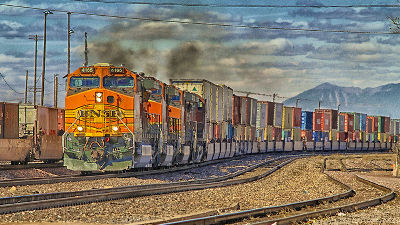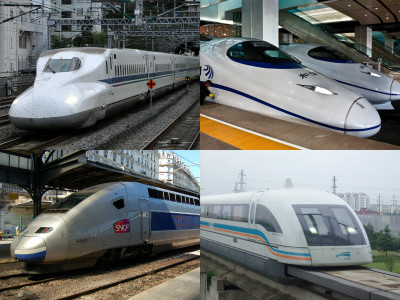A railway world that modernizes more than 100 years with the latest hybrid type "electronically controlled air brake" system

ByClay Gilliland
A train running beyond 1 kilometer from the head to the tail runs over the rails laid out on a vast ground, the "air brake" used in such American freight trains is being modernized at once is. Newly developed "Electronically controlled compressed air brakeCombined conventional air brake and computer technologyHybrid brake systemIt seems that it has become a next generation braking system that has many merits unlike in the past and improves energy efficiency.
Stop That Train! - IEEE Spectrum
http://spectrum.ieee.org/transportation/mass-transit/stop-that-train
This air brake system has been used for a long time in the American freight train, especially since inventor George Westinghouse invented a mechanism to brake train wheels using compressed air in 1869 . Although it is a system of air brake with history and achievement, there is a problem in the case of an American freight train where it is not unusual that the train formation length exceeds one mile (about 1.6 km) unlike in Japan It is said that there are things. It takes physical time of about 150 meters per second for the pressure change of air to be transmitted, it took about 10 seconds for the brake applied at the tip's cab to reach the rear end 1.6 km ahead It is a problem of getting out.
In order to solve this problem, a number of technologies using electronic control were created by rival companies, but Westinghouse continued to reject those braking systems as "low reliability". But here comes a hybrid system that combines compressed air and electronic control. This system which electronically controls the compressed air system provided for each vehicle is called "electronically controlled pneumatic braking:ECP) "And is drawing attention as a mechanism with a big technical advantage.

Regarding ECP, Robert Borg, vice president of Wabeck Railway Electronics, said, "ECP's benefit will be clearly proved," insisting on its superiority over traditional systems I will. The company's parent company Wabtech Corp is a company born after Westinghouse Airbrakes Inc., a company that divides the German-based brake maker New York Air Brakes (NYAB) and the US domestic ECP market It is one of.
Now, in the United States, operation of two routes running vehicles carrying ECP has started, one is by Wabtech, the other is delivered by NYAB. If the benefits of ECP will be evaluated on these routes, it will become more popular in the future, and will continue to be used in South Africa, Brazil, Australia,American Railway AssociationIt is thought that introduction will be advanced on heavyweight cargo routes all over the world that adopt the standards.
As mentioned earlier, in the case of a train formation employing a conventional compressed air brake, there is a disadvantage that it takes time to transmit the operation performed at the head cab to the rear end vehicle.BNSF Railway"In the case of a long train, if the time for the driver to release the brake after releasing the brakes is too short, the rear end of the vehicle is still braked," said Dana Marriott, In particular, if the car is stopped like a curve with a small radius, the derailment accident may happen because the leading car starts pulling earlier, "the operation I tell you the difficulty of.

ByEldelinux
Also, it is a disadvantage of the conventional system that the air pressure is not evenly transmitted to all vehicles and the braking effectiveness is not even. Even if a slight brake is applied, the pressure change is properly transmitted to the vehicle near the head, whereas the pressure change is lost as it goes to the rear, and the brake is not applied at all at the rear end It is not unusual for the situation to be born.
Mr. Marriott of the BNSF railroad, in collaboration with his colleagues, visited a small company in the state of Kansas "TSM" and promoted the development of vehicles equipped with ECP, in 1993 it consists of 65 cars We made cargo formation, so-called "Unit · Train" debut on the route in the northern part of New York. Two years later, for further development, he added four experimental vehicles equipped with ECP on the same route.
These vehicles are equipped with connectors to connect air hoses and wiring cables that connect vehicles as in the past, but the actual usage is totally different. In the case of conventional vehicles, high pressure air passes through the air hose and penetrates from the top to the rear end. In the ECP experimental vehicle, each vehicle is assigned a signal sent from the driver's seat computer It is designed to receive according to the ID.

By the way, at this time, the technology to connect each vehicle wirelessly rather than cable, and to send signals was also considered. However, by draining cables, each vehicle needs to prepare power on its own. Devices that generate electricity by rotation of the axle were devised, but it was said that it was difficult to obtain sufficient reliability in any of them. In addition, the risk of being affected by interference due to the use of radio was pointed out, and according to the advice "If cable can be used, it should be a cable", it means that the control by radio has entered the storage.
The verification of vehicles with ECP gradually began in all parts of the country, and in 1997 the draft that specified the standard is completed. However, at that time, an incident occurred in which each railroad company lost interest in ECP. The reason was that it was "incompatible with existing vehicles". Also, it is said that the cost for replacing the brake system has also started to increase. In the case of a locomotive, it costs 400,000 dollars (about 4.5 million yen) per car and costs 4000 dollars (about 450,000 yen) per car for freight vehicles. As of 2006, all vehicles in the US are converted to ECP Sometimes it was estimated that the cost of replacing it would amount to as much as $ 7.5 billion (about 840 billion yen).
Nonetheless, the ECP has a number of merits that are quite different from the conventional one.
For example, a laboratory organization consisting of 150 freight cars is prepared at the facility of Wabtech, but it is assumed that a braking failure has occurred in only one of these formations. Even in the conventional compressed air brake system, a safety system to avoid abnormality is installed, but in the case of ECP, the fact that "an abnormality occurred at 149 eyes" is immediately transmitted to the cab, the failure information It is registered in the computer. Also in this state you can see that 95% of the brakes in the whole train are in operation. Thus, the advantage of ECP is that it is possible to detect an abnormal part without requiring time and labor.

ByHenk Sijgers
Also, the fact that the effectiveness of brakes can be controlled for each vehicle also has another merit. By implementing "ABS (anti-lock brake system) function" in automobiles, the best brake effect is achieved for each vehicle, so the distance required for stopping is 40 to 60% There are also results that are reduced.
Furthermore, the point that will be appealing to railway companies is that they can realize high efficiency. By installing the ECP, safety performance improves, as a result it will be able to raise the speed of the train, and loss due to equipment troubles and derailment accidents caused by brakes, etc. can be eliminated, so that total The efficiency can be expected to improve. In South African railroad company "Spoornet" which actually introduces ECP, the result is that the time required for one round trip is reduced by 9%. It is said that energy efficiency can be improved by this.
As the railway regulations at the moment are based on conventional systems, there are circumstances in which it is not compatible with the latest systems like ECP. For this reason, the American Railway Association is proceeding with adjustments to allow major railway companies to exclude rules, and furthermore it is proceeding to enact new rules by the end of 2016. It does not seem to be a long way to modernize the braking system by a conventional mechanism that has been used for 150 years.
Related Posts:







